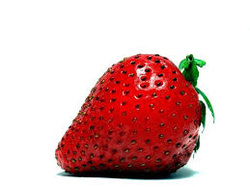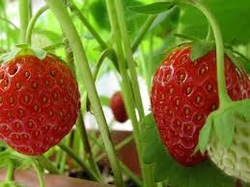
Here's the first line of the Beatles song, Strawberry Fields Forever.
Let me take you down
Cause I'm going to Strawberry Fields
Nothing is real
And nothing to get hung about
Strawberry Fields forever ...
Did you know the strawberry (genus Fragaria), genus of more than 20 species of flowering plants, is part of the rose family (Rosaceae)?
Strawberries are native to the temperate regions of the Northern Hemisphere, and cultivated varieties are widely grown throughout the world. The fruits are rich in vitamin C and are commonly eaten fresh as a dessert fruit.

But did you know the history of strawberries goes back over 2,200 years?
Strawberries grew wild in Italy way back in 234 B.C. The ancient Romans thought strawberries had medicinal powers. They used them to treat everything from depression to fainting to fever, kidney stones, bad breath and sore throats.
The first Europeans tasted them in Virginia when their ships landed there in 1588. Early settlers in Massachusetts enjoyed eating strawberries grown by local American Indians who cultivated strawberries as early as 1643.
The garden strawberry was first bred in Brittany, France, in the 1750s via a cross of Fragaria virginiana from eastern North America and Fragaria chiloensis. Nowadays in France, where they’re believed to be an aphrodisiac, strawberries are served to newlyweds at traditional wedding breakfasts in the form of a creamy sweet soup.

The woodland strawberry (Fragaria vesca), which was the first strawberry species cultivated in the early 17th century.
Some believe the name came from the practice of placing straw around the growing plants for protection, others say the name originated over 1000 years ago because of the runners which spread outward from the plant. The name may have been derived from the Anglo-Saxon verb to strew (spread) and the fruit came to be known as streabergen, straberry, streberie, straibery, straubery, and finally strawberry to the English.
As to healthy properties, strawberries are believed to help reduce the risk of heart disease and certain cancers. They are low in calories and high in vitamins C, B6, K, fiber, folic acid, potassium and amino acids. The high levels of nitrate increases blood and oxygen flow to the muscles. Research suggests that people who load up on strawberries before exercising have greater endurance and burn more calories.
So: anyone for strawberries?





 RSS Feed
RSS Feed
